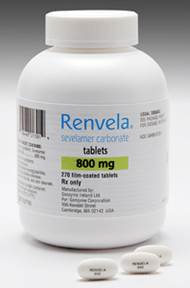Product
Renvela
Approval Date
October 19, 2007
Release Date
March 21, 2008
Company
Genzyme
Class
Phosphate binder
Indication
Control of serum phosphorus in patients with chronic kidneydisease on dialysis.
Active Ingredient
Sevelamer carbonate 800mg; tabs.
Agency Roster
Langland
MarketingStrategy/Execution
Genzyme finds itself facing a marketing Catch-22 with thelaunch of Renvela, a new version of the kidney disease drug sevelamer. That is,promote the new drug too aggressively and run the risk of cannibalizing thepredecessor, Renagel, approved in 1998. Pull back the reins and Renvela couldlanguish. Genzyme says it has the answer: by centering sales efforts onrecruiting new patients, not on switching existing ones, it can grow thesevelamer brand. Some patients may not be taking Renagel due to GIintolerability, and the company’s research suggests Renvela’s carbonate buffermakes it easier on the gut. Genzyme increased its sales force by 30% to 152,and the extra reps will make a deeper push among high-prescribingnephrologists, particularly those who prescribe calcium to dialysis patients.Genzyme expects approval of the pill in non-dialysis patients this year andwill file for a powder formulation in Q2.
The Market
| Specific Antagonists US sales ($000s) last 5 years | |
| 2007 | $1,439,342 |
| 2006 | $1,093,298 |
| 2005 | $791,685 |
| 2004 | $700,398 |
| 2004 | $614,413 |
| Source: IMS Health, Mar. 2008 |
|
| Top 5 specific antagonists |
||
| Total 2007 US sales ($000s) | % sales growth over Total 2006 US sales |
|
| RENAGEL | $435,591 | 28% |
| SUBOXONE |
$304,983 | 96% |
| EXJADE |
$192,150 | 43% |
| FOSRENOL |
$82,141 | 17% |
| PHOSLO |
$66,531 | 44% |
| Source: IMS Health, Mar. 2008 |
||
Also in the Pipeline (According to Adis R&D Insight)
Drug: MCI-196
Manufacturer: Mistubishi Pharma Corporation
Indication: Hyperphosphataemia
Active Ingredient: Colestilan
Phase: III
Source:Wolters Kluwer Health
Physician Outlook
In early March Genzyme announced the launch of its newphosphate binder, Renvela (sevelamer carbonate). Renvela joins Renagel(sevelamer hydrochloride), the most prescribed phosphate binder in the U.S., which isindicated for controlling serum phosphate levels in dialysis patients.Renvela adds to the franchise by providing carbonate-buffered option with thesame effective, active ingredient. Renvela is expected to be pricedcomparably to Renagel, which will help ease adoption and perhaps help expediteits acceptance by managed care. A major complaint associated withphosphate-binding treatments is the frequent dosing needed (3xday), andresearch is underway to both offer a powdered formulation and a once-dailydose. To date, research has not shown QD dosing of Renvela to be non-superiorto Renagel, a necessary hurdle for acceptance.
— Anna Marie Napolitano, VP, category business leader,metabolics, GfK Market Measures
Recent MM&MCoverage
Product News
Product News
Pharmacology
Patients with chronic kidney disease (CKD) can develophyperphosphatemia as a result of retained phosphorus, which may lead to ectopiccalcification. Hyperphosphatemia plays a role in the development of secondaryhyperparathyroidism in CKD. In order to control serum phosphorus, the use ofphosphate binders is used in addition to dietary phosphorus restriction anddialysis.
Sevelamer carbonate is a polymer that binds phosphorus in thedietary tract thereby decreasing the absorption of phosphorus. It also bindsbile acids, which may interfere with normal fat absorption, including fatsoluble vitamins. Additionally it has been shown to reduce the mean total andLDL cholesterol by 15-31%.
Renvela is a calcium-free, metal-free, nonabsorbed phosphate binder.It works similarly to Renagel (sevelamer HCl, also from Genzyme) with thebenefit of a carbonate buffer.
Clinical Trials
The efficacy of sevelamer to control serum phosphorus in CKDpatients on dialysis was determined from the effects of the hydrochloride saltto bind phosphate. Six clinical trials were conducted; one of the six usedsevelamer carbonate. In this trial, Stage 5 chronic kidney disease patients onhemodialysis were entered into a five-week sevelamer HCl run-in period and 79patients were randomized to receive either sevelamer carbonate 800mg tablets orsevelamer HCl 800mg tablets for eight weeks each, with no intervening washout.Study dose during the cross-over period was determined based on the sevelamerHCl dose during the run-in period on a gram per gram basis. The phosphatelevels at the end of each of the two cross-over periods were similar. Averageactual daily dose was 6g/day for both treatment groups. Thirty-nine of thosecompleting the cross-over portion of the study were entered into a two-weekwashout period during which patients were instructed not to take any phosphatebinders; this confirmed the activity of sevelamer in this study.
Adverse Reactions
GI upset, constipation.
Adults
Take with meals. Patients not taking a phosphate binder:serum phosphorus >5.5 and <7.5mg/dL: 1 tablet 3 times daily; =7.5mg/dL: 2tablets 3 times daily. May switch from sevelamer HCl on a gram/gram basis.Switching from calcium acetate: sevelamer carbonate 800mg approximates calciumacetate 667mg (see literature). Titrate by 1 tablet/meal at 2-week intervals tokeep serum phosphorus between 3.5-5.5mg/dL;usual max 14g/day.
Children
Not recommended.
Contraindications
Hypophosphatemia. Bowel obstruction.
Precautions
Dysphagia. Swallowing disorders. Severe GI motilitydisorders. Major GI tract surgery. Monitor serum bicarbonate, chloride levels.Pregnancy (Cat.C). Labor & delivery.
Interactions
May antagonize ciprofloxacin. Separate narrow therapeuticindex drugs by 1 hour before or 3 hours after sevelamer, or consider monitoring(esp. with antiarrhythmics, antiepileptics). Adverse reactions: GI upset,constipation.









